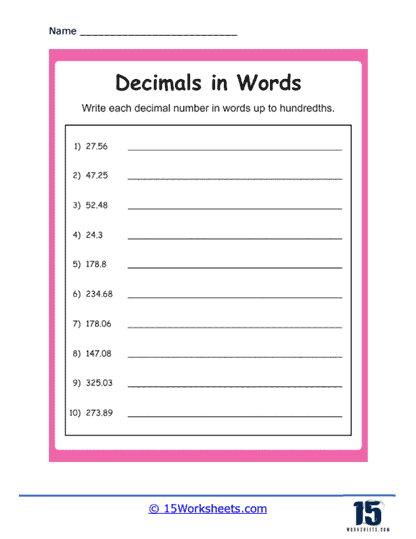

These worksheets are aimed at helping students understand how to express decimal numbers in written form. This skill is important because it contributes to a student’s overall mathematical literacy and ability to communicate numerical concepts effectively.
The worksheets contain a variety of exercises that assist in gradually developing a student’s proficiency in translating decimal numbers into words and vice versa. Some typical exercises found on these worksheets include:
Translating Numerals into Words – The most fundamental exercise involves directly converting decimal numbers into their word form. For example, students might be asked to write “0.25” as “twenty-five hundredths.”
Translating Words into Numerals – Conversely, students might be given a decimal in words and asked to translate it into its numeric form. For instance, they would convert “seven and twenty-six hundredths” into “7.26.”
Fill-in-the-Blank Exercises – These exercises can take many forms. A student might be given a sentence with a missing decimal value that they must fill in, either in numeric or written form.
Multiple Choice Questions – These questions might provide a decimal number and several written options, with the student required to select the correct one. Alternatively, they could be given a decimal written in words and multiple numeric options to choose from.
Word Problems – These real-life scenarios require students to interpret decimal values written in words, write their own decimal values as words, or both. This applies their skills to practical problems.
Practicing with these types of worksheets offers several key benefits to a student’s overall math skills:
Mathematical Literacy – Learning to write decimal numbers in words can significantly enhance a student’s mathematical literacy, aiding them in understanding and communicating about math more effectively.
Number Sense – Converting decimals to words and back again deepens a student’s understanding of decimal place values.
Attention to Detail – The process of translating decimals between numeric and word form requires careful attention to detail, enhancing this important skill.
Problem Solving – Working through word problems and context-based questions promotes the development of problem-solving skills.
The ability to express decimal numbers in words has many practical uses in daily life. When writing checks, for instance, it’s necessary to write out the amount in words, including any decimal values. Similarly, in professional settings, one might need to express decimal values in words in reports or presentations to ensure clarity. Understanding decimal values and being able to express them in written form is also vital in academic contexts, particularly in math and science education.
To write decimals in word form, you can follow these steps:
Step #1 – Identify the place value of each digit in the decimal number. Decimal numbers are written in terms of powers of 10, just like whole numbers, but with a decimal point indicating the position of the decimal.
Step #2 – Write out the whole number part of the decimal as you normally would. This is done just like writing any whole number.
Step #3 – For the decimal part, read each digit individually and state its place value. Use words like “and” to indicate the decimal point. Here’s a breakdown by place value:
Tenths: The first digit to the right of the decimal point represents tenths.
Hundredths: The second digit to the right of the decimal point represents hundredths.
Thousandths: The third digit represents thousandths, and so on.
Use hyphens to connect compound numbers (e.g., twenty-two, fifty-six).
Use the word “zero” for any zero digits.
Here are some examples:
Example #1 – Decimal: 12.34
Word form: Twelve and thirty-four hundredths
Example #2 – Decimal: 0.0072
Word form: Seven thousand two hundredths
Remember to clearly state the place value of each digit and use “point” to denote the decimal point when converting number words to decimal form.
Step #1 – To write number words in decimal form, you can follow these steps:
Step #2 – Start by writing out the whole number part of the decimal number using regular number words.
Step #3 – For the decimal part, you’ll need to state each digit individually by its place value and use words like “point” to indicate the decimal point. Here’s a breakdown by place value:
Use the word “zero” for any zero digits.
Example #1 – Number words: Twenty-three and four tenths
Decimal form: 23.4
Example #2 – Number words: Three thousand four hundred two and fifty-seven ten-thousandths
Decimal form: 3402.0057